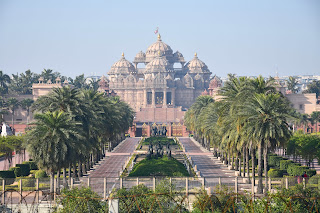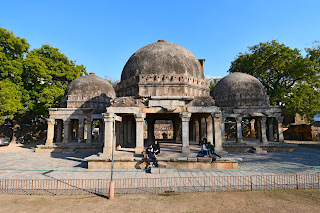Southern Delhi and Other Bits and Pieces
On my last day in Delhi, I managed to cross off the last few items on my sightseeing list. I began by packing my luggage, all the while congratulating myself on having remembered to ask the hotel to do my laundry in advance. That finished, I ordered an Uber to Akshardham, a massive Hindu temple east of the Yamuna River. The opening hours of the temple are not well advertised, and when I arrived by the front gate, I learned it was still closed. For a few minutes, I took pictures of the temple from afar, when suddenly an autorickshaw driver approached me. He reasoned with me that since the temple would not open until ten, I had better come with him and see other sights. I had to admit the soundness of his reasoning and gave him my next address.
After a
rather long ride through the dense morning traffic, we arrived by the Lotus
Temple, a monumental Baha’i place of worship. As its name indicates, it is
built in the shape of a lotus, the white colour of the flower faithfully
replicated by marble. Built in a nonagonal shape, the temple has twenty-seven
“petals” made of panels that fit neatly into one another. What astounded me
most, however, was how well-kept and well-managed the compound was, with
pristine gardens, clean toilets, and an army of employees to deposit visitors’
shoes and welcome them to the temple.
From the
Lotus Temple, my autorickshaw driver and I continued to Mehrauli. The quarter
is home to an archaeological park with a number of ruins, tombs, and wells, but
my driver clearly knew nothing about any of these. Unable to explain to him how
to get where I needed, I got off on the main road and walked. From what I could
tell, the park that leads to the main site is not exactly a tourist magnet, but
the small tombs and ruins eventually grow in size and significance, culminating
in the Quli Tomb. This structure overlooks a placid little lake and offers a
beautiful view of the nearby Qutub Minar. One has to pay a hefty sum for
tickets to this section of the Mehrauli Archaeological Park, but I found it
worthwhile.
What I did
not enjoy about Mehrauli was that despite its being right next to the Qutub
Minar Complex, this second site is inaccessible from Mehrauli. The paths that
clearly point towards Qutub Minar end at closed gates, and one needs to walk
all the way back to the main road and loop around to make the seemingly simple journey.
There were
many more tourists at Qutub Minar than anywhere else in Delhi, and I could see
why. The complex is not just home to the soaring minaret after which it is
named, but also to several beautifully ornate tombs, a mosque, and a madrasa. These
are mostly built of local red sandstone, which is thickly decorated with
beautiful stone carvings. One other interesting sight in the complex is the
Alai Minar, a base for a minaret that was never completed.
From the Qutub
Minar, I took an autorickshaw to the nearby metro station, where I met my
friend Deeksha. She has been back in India for a while but only arrived in
Delhi today. Under her tutelage, I took my first metro ride in Delhi, and I had
to admire how smooth and regular the service was. Indeed, the metro system is a
source of pride to the city’s residents, who make much of its air-conditioned
trains and relatively quiet rides. While one can buy tickets at the machines
and counters, many locals prefer to simply text a number and obtain a ticket
that way.
The only
drawback of the Delhi metro system, and the reason why I have not used it at
all during my time in the city, is that it is not very dense. Upon leaving any
station, a passenger finds a whole retinue of autorickshaws, which act as
relays to various points in the broader neighbourhood. Under Deeksha’s
leadership and thanks to her hard bargaining skills, I had the privilege of
seeing how much locals actually pay for rickshaw rides: about three times less
than I do when left to my own devices.
After
eating lunch in the hip and youthful Hauz Khas, we explored the local fort, an
archaeological site that contains a number of tombs from the early days of the
Delhi Sultanate. We tried to study the local information boards, but as I have
learned during my time in Delhi, these tend to list a barrage of dates rather
than providing real insights. The only exception to this rule is when they
describe visual features that even a layman can distinguish.
From Hauz
Khas, we took an Uber to Rashtrapati Bhavan, Delhi’s main government building. I
was excited to go, as the local gardens from which the edifice can be seen are
heavily advertised at the entrances of many historical sites. However, upon
entering the garden complex we found out that the main attraction – the garden
from which one can view the Rashtrapati Bhavan – had already closed. Instead of
walking on, therefore, we took an autorickshaw to the intersection of Janpath
Road and Kartavya Path, from which tourists traditionally view both Rashtrapati
Bhavan in the west and India Gate in the east.
By then it
was already six o’clock and I was beginning to get nervous about my 11:35
flight to Hanoi. The traffic, I saw, had become quite dense, so it would likely
take a good while to reach the airport. Deeksha ordered an Uber and rode with
me, continuing to the main railway station while I alighted in Paharganj. While
I was not wrong about the traffic, my dread of the security procedures at
Indira Gandhi Airport quickly dissipated. There were not too many people, and
the most annoying thing about the process was watching the security guard in
charge of the X-ray machine stare off into the distance instead of his
computer.












































Comments
Post a Comment